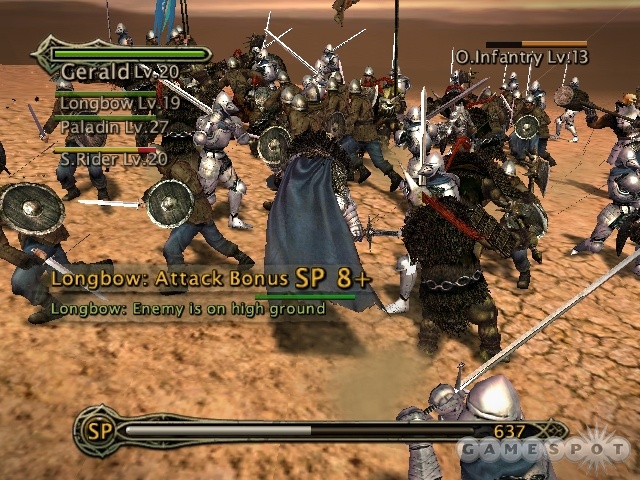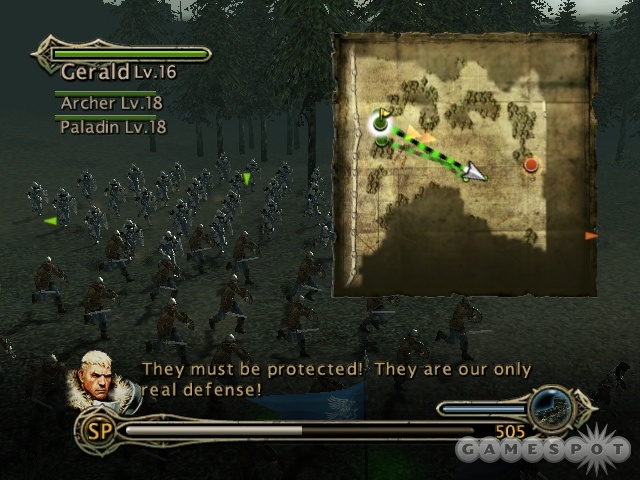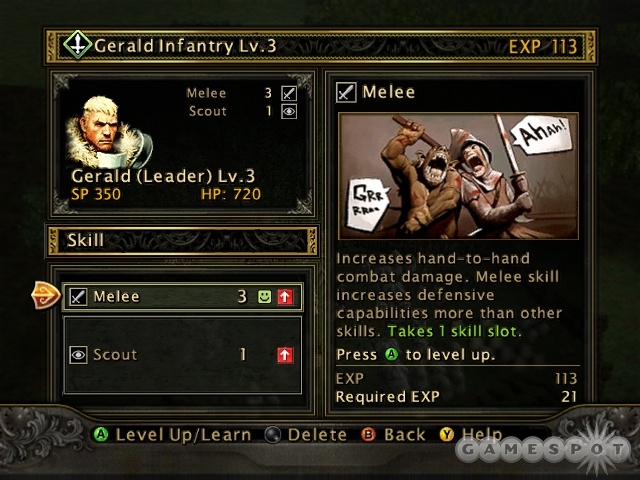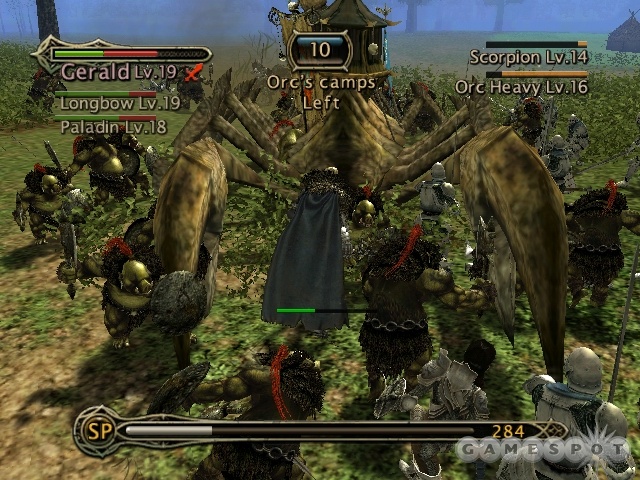Kingdom Under Fire: The Crusaders is the new sequel to 2001's lackluster real-time strategy game Kingdom Under Fire: A War of Heroes, which was released exclusively on the PC. This follow-up, developed by Korean series creator Phantagram, has jumped platforms--from the PC to the Xbox--and has changed genres from a by-the-numbers, overhead RTS to a tantalizing mix of strategy and action the likes of which has rarely been accomplished with such grandiosity. There's so much packed into this game that it's almost too complicated for its own good--almost. But once you climb The Crusaders' steep learning curve and experience the wild frenzy of its massive battles, you'll find all that complexity pays off in spades.

The plot here is a continuation of the story arc begun in A War of Heroes, which recounts the ongoing conflict between the human alliance, consisting of the kingdoms Hironeiden and Ecclesia, and the Dark Legion, a hellish consortium of orcs, ogres, half-vampires, dark elves, and other assorted nasties. The Crusaders picks up about 50 years after the end of the previous game, when the tenuous peace is shattered by a bloody raid on a human village. The strife between the humans and the Dark Legion owes equally to racial hatreds and territorial disputes, with a hotly contested holy ground sometimes coming into play. Oh, and there's a mysterious artifact with awesome powers thrown in for good measure. Much of the game's storyline is exposed by simple talking heads that are set against the world map between missions, although you'll get a good number of dramatically staged cutscenes during battle, too.
The Crusaders' storyline is a little dense. In fact, it's set up by several screens of text (presented when you start the game) that provide little visual or dramatic context. However, the plot does become interesting after you've played a few missions and have gotten to know some of the important characters, and it also provides a fine impetus for all the raging battles that make up the bulk of the gameplay. The game features four campaigns, two for each side and two of which are available for play immediately. Each of the four campaigns has a different playable character who will serve as the commander of your forces, in addition to serving as the warrior you'll get to use during the action component of the game. The remaining two campaigns will become unlocked when you complete the first two, and the storyline progresses in order as you play through all four campaigns (which, in true RTS style, become progressively more difficult as you go).
Anyway, the point of this game is its combat--and what furious combat it is. In short, the gameplay in The Crusaders consists of both real-time strategy, whereby you command regiments of troops to move and attack on the battlefield, and Dynasty Warriors-style hack-and-slash action, in which you take control of your leader and go toe-to-toe, alongside your troops, against (literally) scores of enemies all at once. One of the most impressive things you'll notice right off the bat is that the strategy and the action are mixed together seamlessly. As a result, you'll be commanding your forces one moment, and then you'll be down on the battlefield swinging your sword the next. All the while, the camera never cuts away from one view to another; it merely zooms in closer to the action.
In the strategy parts, you'll command entire groups of soldiers at once, rather than being forced to micromanage individual units (which, let's face it, would be downright impossible using a joystick). The interface for commanding your troops isn't entirely accessible from the get-go, but it gets the job done pretty well, and you'll certainly warm up to it after just a few missions. You cycle through your troop regiments with the shoulder buttons, and the camera will center itself behind whichever group is currently selected. An onscreen cursor allows you to move the troops around, it makes them attack a nearby enemy group, and so on. If you're using this alone, it can be hard to simultaneously get a feel for the events on the battlefield while assigning orders to your troops. Thankfully, you can pull up a minimap that covers up only about a quarter of the screen, and you can move your troops around and assign them to perform all the same actions this way as well. Pretty quickly, it will become second nature for you to pop up the minimap, assign orders to your groups, and then switch back to the action--in seconds--to watch it all go down.

Aside from standard move and attack commands, you can make your units perform all sorts of special abilities, from more-powerful attacks to support techniques to even magic spells (more on that later). There's a wealth of unit types in the game, from basic infantry and archers to specialized, faction-specific troops, like paladins (who can both fight and cast healing magic). Additionally, there are giant scorpions that act as hideously huge, living siege weapons. Some missions require you to bring specific types of units into battle, but often you'll have a couple of slots you can fill with the units of your choice. So perhaps you'll bring sappers, who can set traps to snare enemies, or orc-ghouls, who can self-destruct, causing massive damage to nearby foes.
Though the common troops form the backbone of your war effort, it's the officers who lead them that you'll end up focusing a great deal of your attention on. The unit led by your own character will be with you in every mission, and as soon as it joins battle, the hands-on action starts. You'll immediately be in control of your leader, hacking away at the hordes of enemies all around you while using a variety of melee combos and special moves to tear through, literally, scores of bodies. The action combat in The Crusaders has a good feel to it. You'll really get the feeling that you're engaged in--and are playing a crucial role in--an epically bloody conflict. As you fight, you'll build up skill points that can be used to execute a more powerful attack, summon secondary officers so they can unleash their own powerhouse moves, or initiate some of your troops' aforementioned special abilities.
If all this command-issuing and skull-cleaving sounds like a hell of a lot to keep up with--simultaneously--during a battle...well, it is. At times--mainly early on and before you've gotten a handle on the interface--the game can be too much, especially since it affords you no opportunity to pause the action, formulate your tactics, and issue your commands before moving on. So, initially, players who aren't accustomed to strategy games may find it difficult to get all their troops in the right places, and they may not be able to do the right things fast enough to keep up with the flow of battle. The Crusaders makes you think fast, without a doubt, but once you do get to the point where you can keep up with the action and can start to best the enemy hordes, there's a great feeling of accomplishment waiting for you.

Did you think that was all there was to The Crusaders' gameplay? Not by a long shot. As you fight, you'll transparently accumulate experience points and gold, and between missions you'll visit towns and castles where you can do all sorts of fancy between-missions stuff, like upgrading skills and equipment, hiring mercenaries, eavesdropping at the local tavern for some extra story tidbits, and so on. Frankly, the degree of customization this game offers for your forces is a little bit nuts. It almost seems like it has too many options for its own good, at first. That is, until you witness the effects, firsthand, that a proper round of upgrades can have on your battle performance.
Here's a breakdown in simple terms: You can upgrade the skills and equipment of your main officers, each of whom is attached to a group of soldiers. Skills, such as melee, ranged, and teamwork, have a broad effect on the fighting ability of the group. Equipment, like new weapons and armor, enhances the individual officers, but it also has residual effects on the group's battle prowess as well. Furthermore, when you have a high enough skill level in the right categories, you can learn powerful, new abilities, such as elemental magic attacks that can be unleashed in battle for doling out extra damage. Finally, if your skills are developed in the proper configurations, you can even change your troops' job classes to something entirely different. Converting regular infantry into knights, for example, makes them far more powerful, and archers can become longbowmen to gain extra range and damage potential. Naturally, using the right kind of troops at the right times is key to victory.
A version of this customization setup is available in Kingdom Under Fire's Xbox Live support, which is, unfortunately, a little less fully featured than we'd hoped for, especially given the impressive single-player missions. You'll pick from one of the four playable characters, and then you'll assemble groups of warriors in a manner that's similar to the way you do so in the main game. And as you fight one-on-one battles against other players online, you'll gain experience points that level up your troops and let you both acquire special abilities and change to new jobs, like in the campaigns. The game will match you up with other players who have armies of strength and ability similar to yours, although we ran into a few problems connecting to other players' games after the matching tool had found them. There's also some noticeable lag as you play (which, admittedly, can be affected by your connection speed). The battles online, with their lack of music or dramatic development, feel a little anticlimactic after you've played the carefully set up single-player missions. Still, the online mode ought to be entertaining enough for people who are really into the core gameplay.
Phantagram has coaxed the Xbox into producing some truly stunning visuals in Kingdom Under Fire. The individual units, both for your major characters and the support troops, are pretty highly detailed as it is. Consequently, you'll see cloth rippling, fur bristling, and blood erupting in a gruesome, fine mist as you slash your foes. These units look good already, so imagine there are literally scores of them onscreen at once, locked in combat all around you while you're right in the thick of it, slashing away. There are some truly huge units that pop up in the midst of the regular foot soldiers, such as the towering giant scorpions or the ogres that stand fully twice the height of a human. If you've played the Dynasty Warriors games, you know the basic concept. Just imagine that there are a lot more guys; they're fighting a lot harder; and they're a lot cooler-looking.
The game has a really appealing Europe-as-seen-through-an-Asian-filter aesthetic that produces knights, orcs, and so on that are basically recognizable but that present enough variation to make them interesting. There are a lot of nice touches that lend the battles even more effect, such as the way your soldiers will raise their swords and then hurtle, while screaming, into battle when approaching the enemy. There's also the way you can see a soldier walking down a line of archers, lighting each of their arrowheads before they unleash a volley of fire arrows. It's hard to appreciate the incredible frenzy of the battles in the game by reading about them or by looking at still screenshots of them. It's an effect that's best absorbed when you see the fighting in action.

Phantagram has really outdone itself with the game's soundtrack, too. The battles are underscored by driving metal tracks that serve to amp you up as you go charging headlong into yet another bloody melee. The music is just as heavy in other areas, even between missions. While you're upgrading your troops or checking out the parameters of the next mission, for instance, you'll often hear the deep crunch of power chords in the background. The music is refreshingly consistent with the visual aesthetics and the gritty sounds of battle that you'll hear in every mission. Unfortunately, the English voice acting is decidedly the weakest aspect of The Crusaders' sound. The main characters are usually passable, but some of the supporting characters are downright awful. But you can change the dialogue over to Korean (while maintaining the English subtitles), which is far more emotive and passionate. It's similar to the contrast you get between a well-acted anime in Japanese and its low-budget, English-dubbed counterpart. Once you learn the game's mechanics enough to get along solely through visual cues, you can safely switch to the Korean voice acting for a much more guttural vocal experience during battle.
Given the Kingdom Under Fire series' inauspicious beginnings, it's really a great surprise to see that The Crusaders has turned out to be such a uniquely entertaining game. Make no mistake, though: This is not a game for everyone. You'll need a strong appreciation for hack-and-slash action, strategic warfare, and some light RPG elements to really enjoy the game. Moreover, the daunting learning curve may turn off all but the most committed tacticians. If you're willing to stick with it, though, The Crusaders offers some amazingly epic battles in the many missions spread across its four campaigns. Ultimately, this is the kind of rewarding gameplay experience that's worth putting in a little work for.



